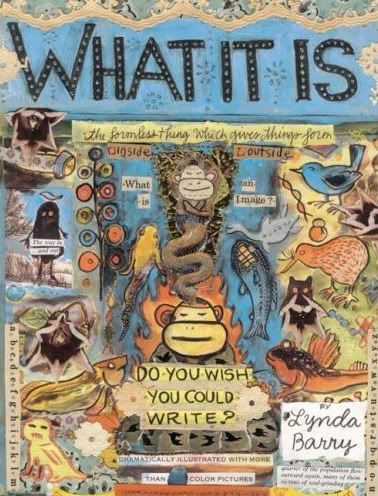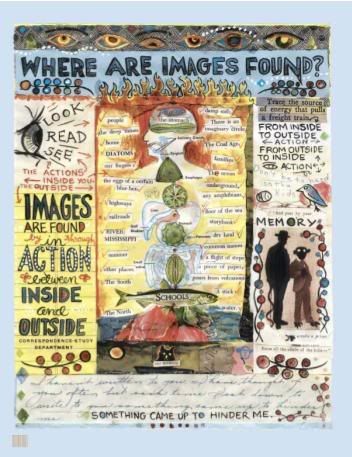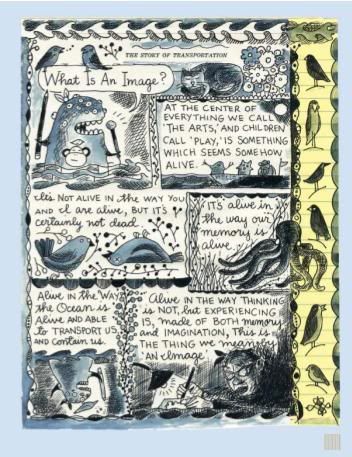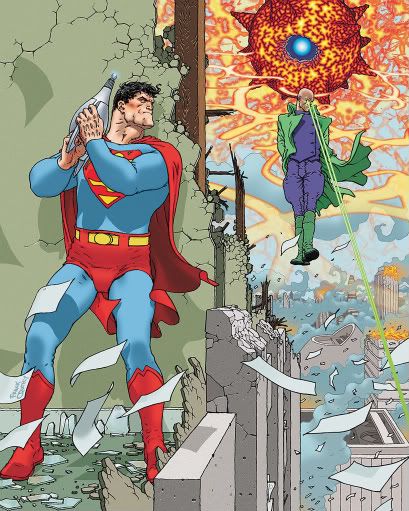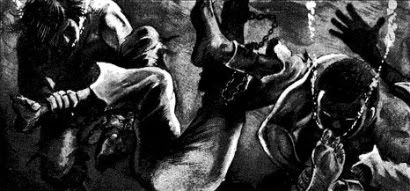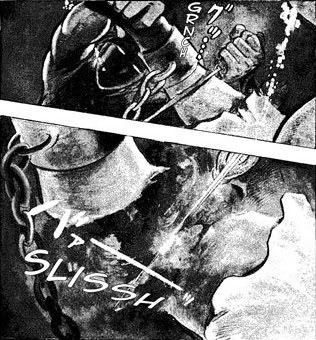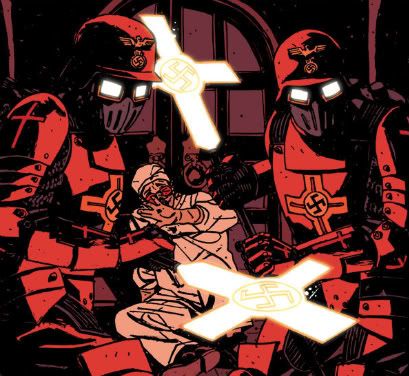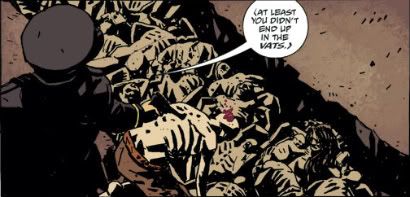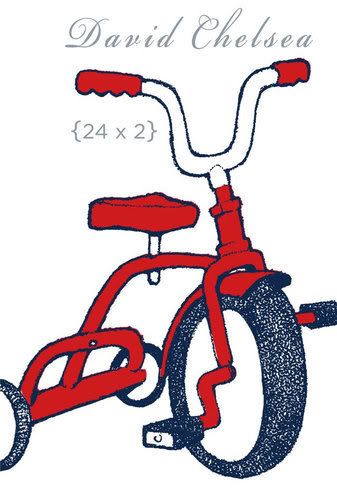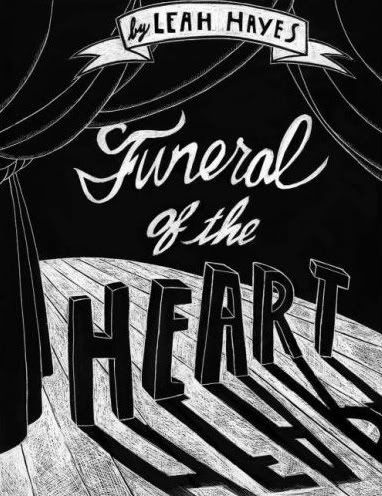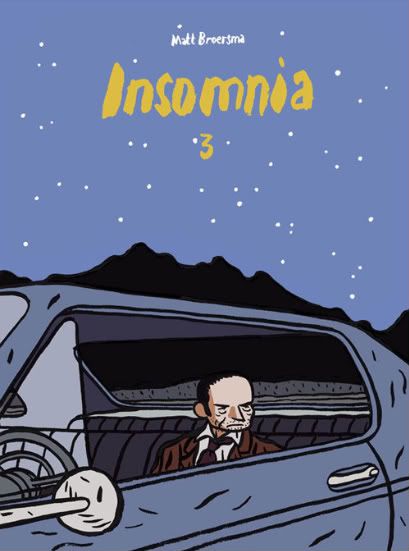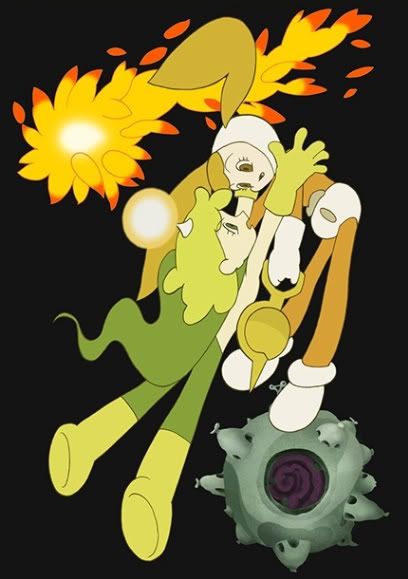Delayed Reactions
*This is a big one. This post, not
LAST WEEK'S REVIEWS:
What It Is (Lynda Barry's new one; certainly worth experiencing)
And!
Tank Girl: Visions of Booga #1 (of 4) and Dead, She Said #1 (of 6)
At The Savage Critics!
It was a holiday.
*Valuable Weblinks Dept. #1: Buy Alan David Doane's comics. Many hot deals remain, like a complete run of Seven Soldiers for $20. Or Eddie Campbell's Batman: The Order of Beasts for a buck. You know how much gas a buck will get you? A slap in the face!
*Valuable Weblinks Dept. #2: Tucker Stone will liveblog an all-day review of the Uncanny X-Men Omnibus Vol. 1 -- that's 850 or so pages of '70s X-Men -- starting this Saturday at about 10:00 AM EST. I tried liveblogging the Oscars once; by the end I was cracking jokes about Tom DeFalco-era Fantastic Four comics, as my family wept in the parlor. Good luck to you, Tucker!
*Valuable Weblinks Dept. #3: I've never worked on a legal document that didn't contain a knee-slapping French joke. All the judges call me Joe French.
*Remember - the Direct Market is a desert until Thursday. Show up Wednesday and your delegates will not be seated.
THIS WEEK IN COMICS!
The Comics Journal #290: Another $11.99 edition, this time featuring a roundtable essay jamboree on David Michaelis's Schulz and Peanuts (featuring, among others, R.C. Harvey and Monte Schulz), an interview with Matt Madden, a Bill Randall column on Daiskue Nishijima, a quintet of Bob Powell horror comics (his Colorama was in Art Out of Time), a selection from Bill Schelly's forthcoming Man of Rock: A Biography of Joe Kubert, and so much more. Put the pages in your mouth and taste.
What It Is: Lynda Barry on the creative life, which might as well be life itself. Drawn & Quarterly, $24.95. Review here.
Speak of the Devil #6 (of 6): The fatal end of Gilbert Hernandez's Dark Horse tribute to knives, trash and bedlam. Only two free pages this time.
Skyscrapers of the Midwest: Being the much-admired series by Joshua Cotter, now tucked away into a 288-page, 6" x 9" monochrome hardcover. Only $19.95. AdHouse is the publisher, and has the preview. Wild heartland fantasy and childhood anxiety, beautifully drawn. Give it a look if you didn't get the pamphlets.
Heartburst and Other Pleasures: Concluding (unless I'm totally wrong) Rick Veitch's suite of self-published reprints for his Epic Illustrated-era material, although the title story here was originally released as Marvel Graphic Novel #10 in 1984. It's the satiric odyssey of young Sunoco Firestone, who discovers vast inner power and the love of a pretty green girl. I got an old, water-damaged copy of the '84 original years back, and the most water damage was to this page, which was a really great discovery. This new, 64-page edition will have refurbished colors and six extra stories, including the original Veitch/Stephen R. Bissette sequential version of Alan Moore's The Mirror of Love. Many samples here.
Judenhass: A new, 56-page book by Dave Sim, extending his current fancy for 'photorealism' comics into an extended reflection on the currents of Jew hatred that fed into the Nazi genocide of WWII. Preview here.
Angry Youth Comix #14: This issue of Johnny Ryan's comic promises to reveal The World's Funniest Joke, so it ought to make you really happy.
Eric Stanton: The Dominant Wives and Other Stories: Another huge, cheap ($14.99!) softcover book of smut from Taschen, this time collecting 576 pages of bondage funnies from the fetish illustration legend and longtime Steve Ditko studiomate. Keep your eyes peeled; you never know who might be inking! Excerpts here.
The Nearly Complete Essential Hembeck Archives Omnibus: Oh lord, speaking of bang for your buck - Image is ready and willing to accept $24.99 in exchange for 912 pages of b&w Fred Hembeck drawings and stories. Intro by Stan Lee. Samples here.
Starman Omnibus Vol. 1 (of 6): Well, Kirby's all finished, so it's on to DC's next $49.99 omnibus project - a full reprinting of writer James Robinson's much-admired 1994-2001 superhero epic. This initial volume collects issues #0-16, so you can relive the Zero Hour tie-in magic, then watch the work flower. Art by Tony Harris. I've never read any of this; actually, the only 'big' works of Robinson's I've gone through are his well-meaning but not very satisfying Witchcraft series for Vertigo, the first of which directly preceded Starman in 1994. This will surely be the easiest way to get all of it in hand.
Jack Kirby's O.M.A.C.: One Man Army Corps: Oh, shit. I guess Kirby isn't finished. What we've got here is an all-in-one DC hardcover -- $24.99 for 176 pages -- collecting the King's eight-issue 1974-75 opus. The hair will be high and the fists will fly.
Superman: World of Krypton: MORE REPRINTS, MORE MORE. I have the sneaking suspicion that the only thing anyone recalls at all about this Walter Simonson-written 1987-88 miniseries is the presence of a certain 27-year old penciller named Mike Mignola - and buddy, that's enough for a trade. Or maybe not, since DC is pumping this $14.99 sucker up to 192 pages with the first issue of John Byrne's The Man of Steel revamp, and assorted Krypton tales from something like 10 other Superman comics.
John Byrne's Complete Next Men Vol. 1: It will never end. All comics will return, including the ones you drew as a child. But for now, IDW begins its b&w 'phonebook'-style reprint of Byrne's signature 1992-94 series. This 432-page, $19.99 tome contains the 1991 kickoff graphic novel 2112 and the first 12 issues of the regular series, with the M4 backup stories included. Should I mention Dark Horse's Savage Sword of Conan Vol. 3, a similarly-styled (and $19.95) compilation of '70s magazines (#25-31)?
The Dangerous Alphabet: From HarperCollins; Neil Gaiman's new children's book, with illustrations by Gris Grimly, $17.99. Preview here. I found this in Diamond's helpful Merchandise section, along with an $18 "Space Robot" - no wonder they didn't want the little fucker in space, if that's all he's worth.
No Pasarán! Vol. 3 (of 3): I'm a tool, so I'll always remember Italian comics master Vittorio Giardino for his naughty Winsor McCay spoof Little Ego, but here's the 72-page, $14.95 conclusion to one of his Max Fridman spy stories, set in the Spanish Civil War. It'll probably look like this. NBM is also offering Vol. 2 again this week, plus Rick Geary's A Treasury of Victorian Murder Vol. 5: The Mystery of Mary Rogers.
Appleseed Vol. 2 (of 4): Prometheus Unbound: In case you were wondering, this is the stuff that formed the basis of both the 1988 OVA and the 2004 movie; it also more-or-less wraps up Masamune Shirow's 'main' plot, with the next two books drifting away into obsessive tactics until the series chokes to a halt. It's $14.95, in the right-to-left format. Dark Horse (with DMP) also has Berserk Vol. 23 this week; I anticipate nothing much will happen, in an attractive manner.
Studio Space: A new $29.99 softcover prose project from Joel Meadows & Gary Marshall, spun off from a recurring feature in the magazine Tripwire, just as Todd Hignite's similarly-themed In the Studio grew out of Comic Art. Featuring peeks into the minds and working spaces of 20 different artists, such as Mike Mignola, Frank Miller, Joe Kubert, Jim Lee, Howard Chaykin, Walter Simonson, Brian Bolland, Dave Gibbons, Sean Phillips, Duncan Fegredo, Sergio Toppi, Tommy Lee Edwards, Adam Hughes, George Pratt, Tim Bradstreet, Tim Sale, Phil Hale, John Bolton, Alex Ross and... one other person? Image is the publisher, and a $49.99 hardcover is also available. A few pages.
Marvel 1985 #1 (of 6): This is a long, long in the making (as in, the script was done in 2005) project from writer Mark Millar, something about Marvel baddies entering 'our' world after Secret Wars, and a 13-year old mega-fan is the only one who knows the secret weaknesses that can stop their terror spree, or something. The initial hype behind it was that it was going to employ a state-of-the-art fumetti visual style, and was going to be very, very expensive to produce. Then a few early images were released to... mixed reactions. Then the whole project vanished for a while, and now it's back and ready to go, with art by Tommy Lee Edwards. Here's some pages, containing a succinct portrayal of the economic tug crossover Events have on the devout readership, from the writer of Civil War. The whole setup seems like a 'serious' mirror image of Millar's current Kick-Ass; funny how time lines things up.
Jimmy Zhingchak: Agent of D.I.S.C.O.: I can't say I was expecting Virgin to release a $5.99 humor one-shot steeped in '80s Bollywood tropes, yet it will indeed appear in stores that sell comic books. From writer Saurav Mohapatra and artist Anupam Sinha. Also from Virgin: Dan Dare #6 (of 7).
The Immortal Iron Fist #15: Penultimate issue of the current team's run, although Ed Brubaker's absent from this issue and Khari Evans is sole penciller. See. This week also has the second hardcover collection of the series, picking up everything besides this.
The Legion of Super-Heroes #42: There's a lot of things out this week.
Giant-Size Astonishing X-Men #1: Like delayed endings to certain 25-issue superhero runs that began almost precisely four years ago. Which, if you average it out, makes it a very snappy bimonthly project! Featuring everyone.
All Star Superman #11: Grant Morrison release #1 for the week. The penultimate issue of this series' regular run, seeing a terrible threat reveal itself as Clark Kent prepares for Superman's death. Action-packed preview here, once you scroll down. Could Lex Luthor's use of "retards" be a nod to a different All Star series?! At this point I'll be sad if Batman doesn't show up for two panels in issue #12 to give us all a goddamn...
Batman #677: Grant Morrison #2, also part 2 (of 6) of the Batman R.I.P. saga (wouldn't you like a handy checklist?). Morrison got really excited over some plot twist in this issue at his New York Comic Con panel, crowing that he couldn't believe that nobody had thought to fuck around with Batman in this particular way before. I like the cheesy Knightfall-style bloody bat-logo at the top right of every tie-in; synchs up with the very '90s hellish future Our Hero is struggling to avoid. Speaking of the '90s, there's few artists of the day I associate with Batman closer than Kelley Jones, and he's got the first of 12 issues for the horror-themed Batman: Gotham After Midnight this week, written by Steve Niles.
Final Crisis #1 (of 7): Yeah, have a look; that does indeed appear to be Anthro on the first page.
LAST WEEK'S REVIEWS:
What It Is (Lynda Barry's new one; certainly worth experiencing)
And!
Tank Girl: Visions of Booga #1 (of 4) and Dead, She Said #1 (of 6)
At The Savage Critics!
It was a holiday.
*Valuable Weblinks Dept. #1: Buy Alan David Doane's comics. Many hot deals remain, like a complete run of Seven Soldiers for $20. Or Eddie Campbell's Batman: The Order of Beasts for a buck. You know how much gas a buck will get you? A slap in the face!
*Valuable Weblinks Dept. #2: Tucker Stone will liveblog an all-day review of the Uncanny X-Men Omnibus Vol. 1 -- that's 850 or so pages of '70s X-Men -- starting this Saturday at about 10:00 AM EST. I tried liveblogging the Oscars once; by the end I was cracking jokes about Tom DeFalco-era Fantastic Four comics, as my family wept in the parlor. Good luck to you, Tucker!
*Valuable Weblinks Dept. #3: I've never worked on a legal document that didn't contain a knee-slapping French joke. All the judges call me Joe French.
*Remember - the Direct Market is a desert until Thursday. Show up Wednesday and your delegates will not be seated.
THIS WEEK IN COMICS!
The Comics Journal #290: Another $11.99 edition, this time featuring a roundtable essay jamboree on David Michaelis's Schulz and Peanuts (featuring, among others, R.C. Harvey and Monte Schulz), an interview with Matt Madden, a Bill Randall column on Daiskue Nishijima, a quintet of Bob Powell horror comics (his Colorama was in Art Out of Time), a selection from Bill Schelly's forthcoming Man of Rock: A Biography of Joe Kubert, and so much more. Put the pages in your mouth and taste.
What It Is: Lynda Barry on the creative life, which might as well be life itself. Drawn & Quarterly, $24.95. Review here.
Speak of the Devil #6 (of 6): The fatal end of Gilbert Hernandez's Dark Horse tribute to knives, trash and bedlam. Only two free pages this time.
Skyscrapers of the Midwest: Being the much-admired series by Joshua Cotter, now tucked away into a 288-page, 6" x 9" monochrome hardcover. Only $19.95. AdHouse is the publisher, and has the preview. Wild heartland fantasy and childhood anxiety, beautifully drawn. Give it a look if you didn't get the pamphlets.
Heartburst and Other Pleasures: Concluding (unless I'm totally wrong) Rick Veitch's suite of self-published reprints for his Epic Illustrated-era material, although the title story here was originally released as Marvel Graphic Novel #10 in 1984. It's the satiric odyssey of young Sunoco Firestone, who discovers vast inner power and the love of a pretty green girl. I got an old, water-damaged copy of the '84 original years back, and the most water damage was to this page, which was a really great discovery. This new, 64-page edition will have refurbished colors and six extra stories, including the original Veitch/Stephen R. Bissette sequential version of Alan Moore's The Mirror of Love. Many samples here.
Judenhass: A new, 56-page book by Dave Sim, extending his current fancy for 'photorealism' comics into an extended reflection on the currents of Jew hatred that fed into the Nazi genocide of WWII. Preview here.
Angry Youth Comix #14: This issue of Johnny Ryan's comic promises to reveal The World's Funniest Joke, so it ought to make you really happy.
Eric Stanton: The Dominant Wives and Other Stories: Another huge, cheap ($14.99!) softcover book of smut from Taschen, this time collecting 576 pages of bondage funnies from the fetish illustration legend and longtime Steve Ditko studiomate. Keep your eyes peeled; you never know who might be inking! Excerpts here.
The Nearly Complete Essential Hembeck Archives Omnibus: Oh lord, speaking of bang for your buck - Image is ready and willing to accept $24.99 in exchange for 912 pages of b&w Fred Hembeck drawings and stories. Intro by Stan Lee. Samples here.
Starman Omnibus Vol. 1 (of 6): Well, Kirby's all finished, so it's on to DC's next $49.99 omnibus project - a full reprinting of writer James Robinson's much-admired 1994-2001 superhero epic. This initial volume collects issues #0-16, so you can relive the Zero Hour tie-in magic, then watch the work flower. Art by Tony Harris. I've never read any of this; actually, the only 'big' works of Robinson's I've gone through are his well-meaning but not very satisfying Witchcraft series for Vertigo, the first of which directly preceded Starman in 1994. This will surely be the easiest way to get all of it in hand.
Jack Kirby's O.M.A.C.: One Man Army Corps: Oh, shit. I guess Kirby isn't finished. What we've got here is an all-in-one DC hardcover -- $24.99 for 176 pages -- collecting the King's eight-issue 1974-75 opus. The hair will be high and the fists will fly.
Superman: World of Krypton: MORE REPRINTS, MORE MORE. I have the sneaking suspicion that the only thing anyone recalls at all about this Walter Simonson-written 1987-88 miniseries is the presence of a certain 27-year old penciller named Mike Mignola - and buddy, that's enough for a trade. Or maybe not, since DC is pumping this $14.99 sucker up to 192 pages with the first issue of John Byrne's The Man of Steel revamp, and assorted Krypton tales from something like 10 other Superman comics.
John Byrne's Complete Next Men Vol. 1: It will never end. All comics will return, including the ones you drew as a child. But for now, IDW begins its b&w 'phonebook'-style reprint of Byrne's signature 1992-94 series. This 432-page, $19.99 tome contains the 1991 kickoff graphic novel 2112 and the first 12 issues of the regular series, with the M4 backup stories included. Should I mention Dark Horse's Savage Sword of Conan Vol. 3, a similarly-styled (and $19.95) compilation of '70s magazines (#25-31)?
The Dangerous Alphabet: From HarperCollins; Neil Gaiman's new children's book, with illustrations by Gris Grimly, $17.99. Preview here. I found this in Diamond's helpful Merchandise section, along with an $18 "Space Robot" - no wonder they didn't want the little fucker in space, if that's all he's worth.
No Pasarán! Vol. 3 (of 3): I'm a tool, so I'll always remember Italian comics master Vittorio Giardino for his naughty Winsor McCay spoof Little Ego, but here's the 72-page, $14.95 conclusion to one of his Max Fridman spy stories, set in the Spanish Civil War. It'll probably look like this. NBM is also offering Vol. 2 again this week, plus Rick Geary's A Treasury of Victorian Murder Vol. 5: The Mystery of Mary Rogers.
Appleseed Vol. 2 (of 4): Prometheus Unbound: In case you were wondering, this is the stuff that formed the basis of both the 1988 OVA and the 2004 movie; it also more-or-less wraps up Masamune Shirow's 'main' plot, with the next two books drifting away into obsessive tactics until the series chokes to a halt. It's $14.95, in the right-to-left format. Dark Horse (with DMP) also has Berserk Vol. 23 this week; I anticipate nothing much will happen, in an attractive manner.
Studio Space: A new $29.99 softcover prose project from Joel Meadows & Gary Marshall, spun off from a recurring feature in the magazine Tripwire, just as Todd Hignite's similarly-themed In the Studio grew out of Comic Art. Featuring peeks into the minds and working spaces of 20 different artists, such as Mike Mignola, Frank Miller, Joe Kubert, Jim Lee, Howard Chaykin, Walter Simonson, Brian Bolland, Dave Gibbons, Sean Phillips, Duncan Fegredo, Sergio Toppi, Tommy Lee Edwards, Adam Hughes, George Pratt, Tim Bradstreet, Tim Sale, Phil Hale, John Bolton, Alex Ross and... one other person? Image is the publisher, and a $49.99 hardcover is also available. A few pages.
Marvel 1985 #1 (of 6): This is a long, long in the making (as in, the script was done in 2005) project from writer Mark Millar, something about Marvel baddies entering 'our' world after Secret Wars, and a 13-year old mega-fan is the only one who knows the secret weaknesses that can stop their terror spree, or something. The initial hype behind it was that it was going to employ a state-of-the-art fumetti visual style, and was going to be very, very expensive to produce. Then a few early images were released to... mixed reactions. Then the whole project vanished for a while, and now it's back and ready to go, with art by Tommy Lee Edwards. Here's some pages, containing a succinct portrayal of the economic tug crossover Events have on the devout readership, from the writer of Civil War. The whole setup seems like a 'serious' mirror image of Millar's current Kick-Ass; funny how time lines things up.
Jimmy Zhingchak: Agent of D.I.S.C.O.: I can't say I was expecting Virgin to release a $5.99 humor one-shot steeped in '80s Bollywood tropes, yet it will indeed appear in stores that sell comic books. From writer Saurav Mohapatra and artist Anupam Sinha. Also from Virgin: Dan Dare #6 (of 7).
The Immortal Iron Fist #15: Penultimate issue of the current team's run, although Ed Brubaker's absent from this issue and Khari Evans is sole penciller. See. This week also has the second hardcover collection of the series, picking up everything besides this.
The Legion of Super-Heroes #42: There's a lot of things out this week.
Giant-Size Astonishing X-Men #1: Like delayed endings to certain 25-issue superhero runs that began almost precisely four years ago. Which, if you average it out, makes it a very snappy bimonthly project! Featuring everyone.
All Star Superman #11: Grant Morrison release #1 for the week. The penultimate issue of this series' regular run, seeing a terrible threat reveal itself as Clark Kent prepares for Superman's death. Action-packed preview here, once you scroll down. Could Lex Luthor's use of "retards" be a nod to a different All Star series?! At this point I'll be sad if Batman doesn't show up for two panels in issue #12 to give us all a goddamn...
Batman #677: Grant Morrison #2, also part 2 (of 6) of the Batman R.I.P. saga (wouldn't you like a handy checklist?). Morrison got really excited over some plot twist in this issue at his New York Comic Con panel, crowing that he couldn't believe that nobody had thought to fuck around with Batman in this particular way before. I like the cheesy Knightfall-style bloody bat-logo at the top right of every tie-in; synchs up with the very '90s hellish future Our Hero is struggling to avoid. Speaking of the '90s, there's few artists of the day I associate with Batman closer than Kelley Jones, and he's got the first of 12 issues for the horror-themed Batman: Gotham After Midnight this week, written by Steve Niles.
Final Crisis #1 (of 7): Yeah, have a look; that does indeed appear to be Anthro on the first page.
Labels: this week in comics
